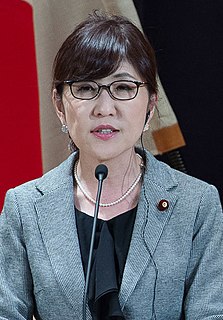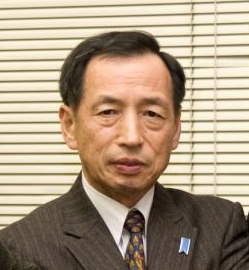 W
WThe Happiness Realization Party , abbreviated as 幸福, is a Japanese political party founded by Ryuho Okawa on 23 May 2009 "in order to offer the Japanese people a third option" for the elections of August 2009. The HRP is the political wing of the conservative and anti-communist Happy Science religious movement.
 W
WTakeo Hiranuma is a Japanese politician and a member of the House of Representatives. He is a member of the Liberal Democratic Party and is former chairperson of the Party for Future Generations.
 W
WTomomi Inada is a Japanese lawyer and politician serving as a member of the Japanese House of Representatives, representing the 1st Fukui Prefecture since September 2005. She previously served as the 14th Japanese Minister of Defense from August 2016 to July 2017, resigning in response to a cover up scandal within the Japanese Ministry of Defense. She spent time as the Chairwoman of the Policy Research Council of the Liberal Democratic Party in her fourth term as a member of the House of Representatives in the Diet. She is a native of Fukui Prefecture.
 W
WShintaro Ishihara is a Japanese politician and writer who was Governor of Tokyo from 1999 to 2012. Being the former leader of right-leaning Japan Restoration Party, Ishihara is one of the most prominent conservative right-wing politicians in modern Japanese politics.
 W
WTakashi Kawamura is a Japanese politician of the Nagoya-based Genzei Nippon party, currently serving as Mayor of Nagoya. He was previously a member of the House of Representatives in the Diet.
 W
WAmong the members, former members, and members of affiliated organizations of the Nippon Kaigi are lawmakers, cabinets ministers and a few prime ministers. The chairman is Toru Miyoshi, former Chief Justice of the Supreme Court of Japan.
 W
WMakoto Sakurai is the pen name of a political activist, blogger, and writer from Kitakyushu in Fukuoka Prefecture, Japan. A former civil servant in a ward office, he is the founder and former leader of the fascist group Zaitokukai, known for its anti-foreign views and unruly demonstrations. Following his unsuccessful campaign in the 2016 Tokyo gubernatorial election, he founded the Japan First Party in August 2016 and is currently the party's leader.
 W
WSankei Shimbun is a daily newspaper in Japan published by the Sankei Shimbun Co., Ltd. It has the sixth highest circulation for a newspapers in Japan, and is considered one of the five leading "national" newspapers.
 W
WKoichi Sugiyama is a Japanese composer, conductor, and orchestrator. Sugiyama is known for composing the music for the Dragon Quest video game series, along with several other games, anime, film, and television shows. A classically trained conductor, Sugiyama is considered a major inspiration for other Japanese game music composers, such as Nobuo Uematsu, who cited him as the "big boss of game music". He is also a council member of the Japanese Society for Rights of Authors, Composers, and Publishers (JASRAC), board member of the Japan Institute for National Fundamentals, and honorary chairman of the Japanese Backgammon Society.
 W
WGeneral Toshio Tamogami is a Japanese Air Self-Defense Force career military officer. He served as the Chief of Staff of Japan's Air Self-Defense Force from March 2007 until October 2008. Tamogami turned to politics in 2014 as a candidate for governor of Tokyo and for the House of Representatives; he was arrested in April 2016 for alleged violations of campaign finance laws in relation to his gubernatorial campaign.
 W
WYuko Tojo was a Japanese ultra-nationalist politician, Imperial Japanese apologist, and brief political hopeful. She was the granddaughter of General Hideki Tōjō, the Japanese wartime prime minister who was convicted of planning and orchestrating most of the major Japanese acts of aggression of World War II; for these crimes, Hideki Tojo was convicted as a Class A war criminal and hanged after World War II in 1948.
 W
WYasukuni Shrine is a Shinto shrine located in Chiyoda, Tokyo. It was founded by Emperor Meiji in June 1869 and commemorates those who died in service of Japan from the Boshin War of 1868–1869 through the First Indochina War of 1946–1954. The shrine's purpose has been expanded over the years to include those who died in the wars involving Japan spanning from the entire Meiji and Taishō periods, and the lesser part of the Shōwa period.